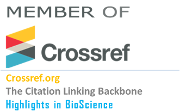Implementation of the Pareto principle in focus group generation based on global coronavirus disease morbidity and mortality rates
Abstract
Keywords
Full Text:
View Full TextReferences
Keshky E, El Sayed M, Basyouni SS, Al Sabban AM. Getting through COVID-19: The pandemics impact on the psychology of sustainability, quality of life, and the global economyA sys- tematic review. Frontiers in Psychology. 2020:3188.
OCHA Services. Novel Coronavirus (COVID-19) Cases Data [Internet]. HUMANITARIAN DATA EXCHANGE. 2022 [cited 30 March 2022]. Available from: https://data.humdata.org/dataset/novel-coronavirus-2019-ncov-cases
Eissa M. Avian schistosomes impact on public health: a long- term disease observation. Annals of Medical Research. 2019;(0):1- 2.
ESSA M, RASHED E. Inventory Digital Management Using Whitehead A. 60/40 Is The New Neutral Pareto Ratio [Internet]. SeekingAlpha. 2022 [cited 30 March 2022]. Available from: https://seekingalpha.com/article/4198408-60-40-is-new-neutral-pareto-ratio
Mitra A. Fundamentals of quality control and improvement. John Wiley & Sons; 2016 May 2.
Pan American Health Organization / World Health Organization. Epidemiological Update: Coronavirus disease (COVID-19). 27 September 2021, Washington, D.C.: PAHO/WHO; 2021
Yu X, Li N, Dong Y. Observation on Chinas Strategies to Prevent the Resurgence of the COVID-19 Epidemic. Risk Management and Healthcare Policy. 2021;14:2011.
AlTakarli NS. Chinas response to the COVID-19 outbreak: A model for epidemic preparedness and management. Dubai Med- ical Journal. 2020;3(2):44-9.
An agency of the European Union. COVID-19 situation update worldwide, as of week 11 updated 24 March 2022 [Internet]. Eu- ropean Centre for Disease Prevention and Control. 2022 [cited 31 March 2022]. Available from: https://www.ecdc.europa.eu/en/ geographical-distribution-2019-ncov-cases
Mecenas P, Bastos RT, Vallinoto AC, Normando D. Effects of temperature and humidity on the spread of COVID-19: A sys- tematic review. PLoS one. 2020 Sep 18;15(9):e0238339.
Bukhari Q, Jameel Y. Will coronavirus pandemic diminish by summer?. Available at SSRN 3556998. 2020 Mar 17.
Ma Y, Pei S, Shaman J, Dubrow R, Chen K. Role of meteoro- logical factors in the transmission of SARS-CoV-2 in the United States. Nature Communications. 2021 Jun 14;12(1):1-9.
Ganegoda NC, Wijaya KP, Amadi M, Erandi KK, Aldila D. Inter- relationship between daily COVID-19 cases and average temper- ature as well as relative humidity in Germany. Scientific reports. 2021 May 28;11(1):1-6.
DOI: https://doi.org/10.36462/H.BioSci.202204
Refbacks
- There are currently no refbacks.
Copyright (c) 2022 Eissa et al.

This work is licensed under a Creative Commons Attribution 4.0 International License.
...........................................................................................................................................................
Other "Highlights in" Journals
Highlights in Bioinformatics, Highlights in Chemistry, Highlights in Science, Highlights in Microbiology, Highlights in Plant Science
........................................................................................................................................
International Library of Science "HighlightsIn" is an Open Access Scientific Publishers, aiming to science and knowledge support













